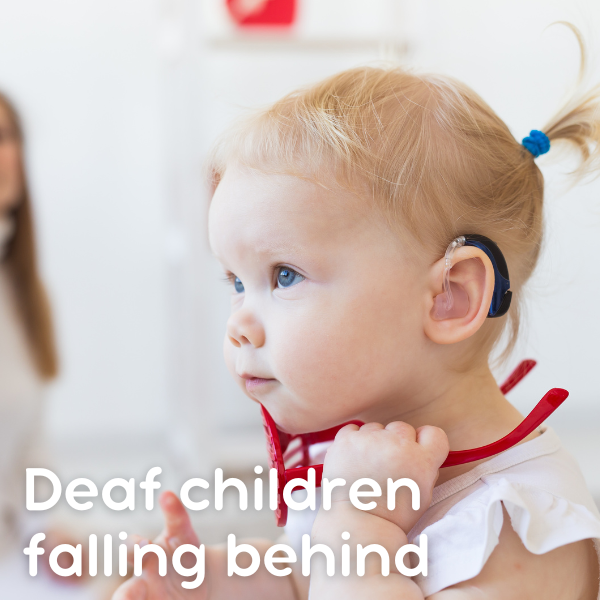
“We’re failing deaf children” – that’s the blunt conclusion from the National Deaf Children’s Society after it was revealed two-thirds of deaf children in England are already behind their peers by their first year in school.
Deaf children (65%) are almost twice as likely as all children (34%) to complete their first year of school without having achieved a ‘good level of development’, according to recent Government statistics. (1)
In recent years, there has been growing concern over the educational attainment of D/deaf* children in the early years of their education. Recent government statistics have shed light on a troubling trend: D/deaf children are falling behind their hearing peers.
This discrepancy is not only a matter of concern for parents and educators but also highlights the urgent need for reforms and increased support to ensure that every child, regardless of their hearing ability, has an equal opportunity to succeed in their early years of education.
Understanding the Statistics
The latest government statistics reveal a stark reality – D/deaf children are lagging behind in various aspects of their early years education. While it’s essential not to generalise and acknowledge the diversity of experiences among D/deaf children, these statistics provide valuable insights into the challenges they face. Here are some key points highlighted by the data:
1. Communication Gaps: D/deaf children often struggle to develop language and communication skills on par with their hearing peers. This can result in delayed speech and language development, hindering their ability to express themselves and understand instructions.
2. Literacy and Numeracy Skills: Many D/deaf children struggle with literacy and numeracy skills. This can have long-term consequences, as these foundational skills are critical for success in later years of education and life.
3. Social and Emotional Development: D/deaf children may face challenges in social and emotional development due to communication barriers. They may experience feelings of isolation and frustration, impacting their overall well-being and mental health.
4. Limited Access to Support Services: Access to specialised support services, such as speech and language therapy and sign language interpretation, can be limited for D/deaf children, further exacerbating their educational challenges.
5. Teacher Training and Awareness: Many early years educators may not have adequate training or awareness to effectively support D/deaf children in their classrooms. This can lead to missed opportunities for early intervention and support.
Root Causes
Several factors contribute to the educational disparities faced by deaf children in their early years:
1. Communication Barriers: The most significant hurdle is the communication barrier. D/deaf children may struggle to understand spoken language and express themselves effectively. This barrier can hinder their ability to engage with their peers and educators.
2. Limited Access to Early Intervention: Early intervention is crucial for addressing developmental delays in deaf children. Unfortunately, many deaf children do not receive the necessary support early enough, leading to long-term consequences.
3. Inadequate Teacher Training: Many early years educators may not have received training in working with deaf students or understanding their unique needs. This lack of awareness can result in missed opportunities for effective teaching and support.
4. Resource Allocation: Schools and educational institutions may not allocate sufficient resources to support D/deaf children adequately. This can include funding for specialised services and technology, such as hearing aids or cochlear implants.
5. Parental Support: The involvement and support of parents and caregivers are vital in a child’s early years. D/deaf children may not receive the same level of support and guidance at home if parents are not adequately informed or have access to resources.
Addressing the Issue
To ensure that D/deaf children have an equal opportunity to succeed in their early years of education, several steps can be taken:
1. Early Intervention Programs: Early intervention programs tailored to the needs of D/deaf children should be readily available and accessible to all families.
2. Teacher Training: Educators should receive training on how to support D/deaf children effectively. This includes learning basic sign language and understanding the unique challenges these students face.
3. Accessible Resources: Schools should provide the necessary resources, such as assistive technology and specialised support services, to accommodate the needs of D/deaf children.
4. Parental Education and Support: Parents and caregivers should be educated about the resources and support available for their D/deaf children. Building a strong support network is essential.
5. Inclusive Education: Promote inclusive education practices that encourage the integration of D/deaf children into mainstream classrooms, fostering a sense of belonging and acceptance among their hearing peers.
The recent government statistics highlighting the educational disparities faced by D/deaf children in their early years are a wake-up call for policymakers, educators, and society as a whole. Every child deserves a fair chance at a quality education and a bright future. By addressing the root causes of this issue and implementing effective solutions, we can ensure that deaf children are no longer left behind, but rather empowered to thrive and succeed in their early years and beyond.

